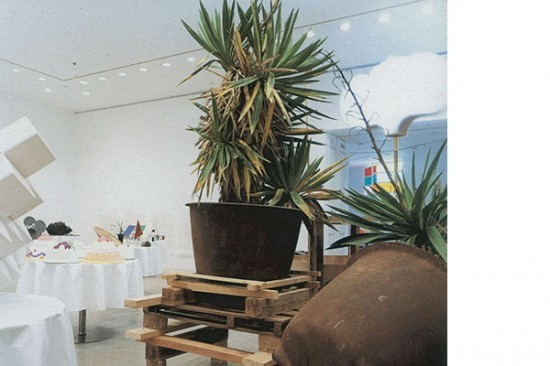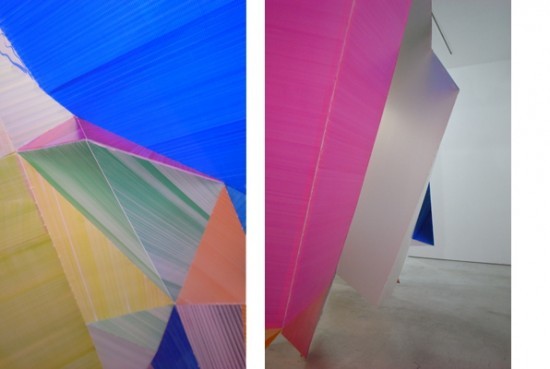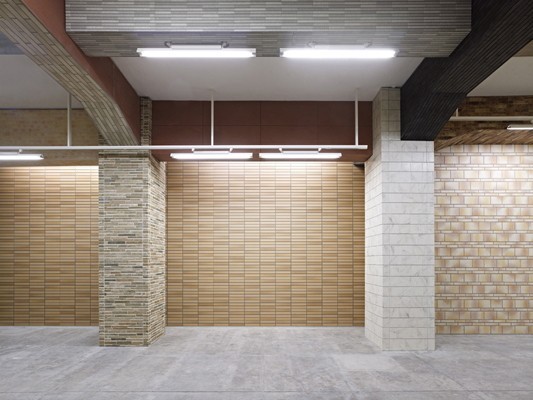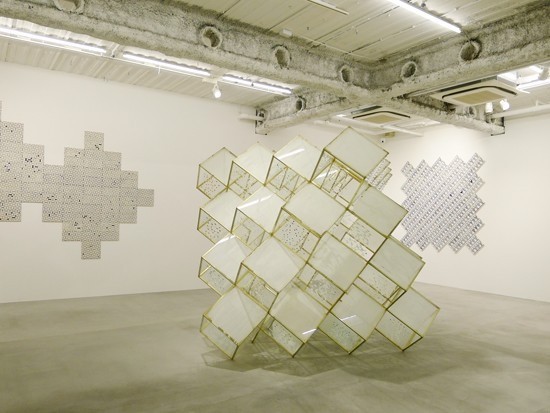Tracing Masanori Handa, 2007-2011
Curated by Midori Matsui, “The Door into Summer: the Age of Micropop,” held at Art Tower Mito in 2007, took a fresh look at Japanese contemporary art since 1995. Premised on the concept of a “door into summer” that “embodies the immediacy and fluidity of life,” the exhibition offered visitors a real sense of the process whereby, for over a period of some 12 years in Japan, this “door” had gradually opened by way of such symbols as children and minors, then closed as “children” and “minors” become incorporated into the “endless everyday,” only to open again into a free-and-easy “summer” not reliant on any particular symbols. At the end of this exhibition, Matsui included Masanori Handa’s World Frontier Expo as an example of work by someone in the vanguard of art not constrained by the symbols of children, minors, chaos and the outside; in other words, someone beyond “Micropop.”

World Frontier Expo (2007), installation view at “The Door into Summer: The Age of Micropop” (2007), Art Tower Mito. Photo Mie Morimoto. All images: © Masanori Handa, courtesy Ota Fine Arts, Tokyo.
Naturally, Handa cannot be placed in this position without changing the discourse with respect to him. However, many art critics untiringly continue to follow the same old schema. After establishing a dualism comprising a system in which human thoughts and symbols are differentiated and the absolute outside of such a system, they explain that the former is confronted by the latter and dismantled, reassembled and reborn as a new system, which in due course is confronted once again with the outside…. This ever-repeating, dialectical process is what they call art. The world of things that exist as they are takes artists “by surprise.” Art that points to “encounters” with an undifferentiated world is art that “does not create” – art that nullifies art. If this were the end of the matter, then there would be no need to progress beyond the likes of Sartre’s Nausea, Surrealism, or, to cite a more recent example, Robert Smithson’s dedifferentiation, and their argument would only have meaning as a reference position with respect to art history of the past. That many critics lapse into a state of aphasia when confronted with Masanori Handa’s artwork is because the modern dualism upon which they premise their arguments, and the narratives that result from this, do not hold true for Handa.
It is precisely this kind of separation of Masanori Handa from the dream of modernism that provides opportunities to “turn off,” as he puts it. The dualistic criticism outlined above prompts questions in return. Is there really nothing outside the differentiated system? Are we denied completely encounters with the vibrant world around us? Surely a life in which we cannot experience the outside around us cannot exist – although it is possible that this outside is for others a totally mundane, boring everyday life. Others nullify my “outside = others.” That most poignant of experiences, the “outside,” is all too easily denied, replaced with the kind of shame that sets the body ablaze. “Turning off” is the experience of having one’s “inside” and “outside” torn apart in an instant after one is led to believe that one has ventured into the dedifferentiated “outside.” Handa’s “turning off” resets the modern repetition-compulsion of the encounter with the “outside.” Handa then carefully gathers the rubble that remains after this destruction, rubble that is no longer either “inside” or “outside,” and reconstructs it in accordance with his delicate formal sensibility, “creating” uninhibited artworks that are neither closed off to the inside nor longing for the outside. In other words, he constructs “freedom” that is not a slave to freedom.

August (2008). Installation view at Kodama Gallery, Tokyo.
“Inside” and “outside” are keywords glimpsed from time to time in Handa’s artwork in recent years. For his solo exhibition “August” (2008, Kodama Gallery, Tokyo), he created inside the gallery space (“interior 1”) an irregular polyhedral enclosure (“interior 2”) made of colorfully painted sheets of plastic, with visitors required to walk through the narrow gap between these two “interiors.” In other words, the “exterior” of “interior 2” = “interior 1.” The image is of an autistic person dreaming of the “outside” and projecting this onto their own exterior, and the results could perhaps be described as the audience sightseeing this colorful vision from the outside.
Thereafter, Handa won a scholarship to study in Germany for a year with Rebecca Horn, and his first solo exhibition upon returning presented 2010’s Study (αM Gallery, Tokyo). In the sense that it dealt with the boundary between inside and outside, the subject of this exhibition, in which interior walls were covered with the kind of cladding material used on the outside of buildings, was “Japan.” This was an orthodox choice of subject for a show marking his return home.

Study (2010). Site-specific installation for “Metamorphosis – Objects Today vol 8, Masanori Handa” (2010), αM Gallery, Tokyo. Photo Daici Ano.
Siding, a kind of cladding material for the outside of buildings, is a product of the same culture that makes both sausages and imitation crabsticks from fish meat. This culture treats the sense of sight (appearance/color) and the sense of touch (texture/consistency) as parts of a continuum. To put it another way, in Japan, unlike in the West, the sense of sight has never assumed a dominant position with respect to the sense of touch. It is for this reason that one can collage anything using the visual = tactual “effect” alone. This is Japanese subject-less “freedom.” This freedom is presented as desolate, empty space. It is “typically Japanese” in the same way that no distinction is made between crabsticks and crabmeat, between fish meat and game meat, between cement and marble, between cement and timber. Any steadfast, dull “thing” that resolutely and unconditionally continues to exist can be substituted with ease for the surface effect of siding. One only needs to step outside to realize that almost the entire city is covered in this kind of exterior cladding material. No, covered is not the right word. Because siding is not used to conceal anything. There are no “things” or “absolute outside” in Japan to begin with. This is the lesson we can draw from the reticent Study. Compared to this, the Mono-ha movement, with its longing for “encounters,” was positively Western.

Roppongi Mosque (2011). Installation view at Ota Fine Arts, Tokyo.
Roppongi Mosque (exhibited at Ota Fine Arts, Tokyo) and Green Silhouette (exhibited at the National Museum of Art, Osaka), both from 2011, also use the same exterior cladding material = interior cladding material (although in these cases not siding, but mosaic tiles) in addressing the theme of the “absolute” that is missing from Japan. As in commonly known, in Islam, which forbids idolatry, the tessellation-like, symmetrical geometric patterns seen in mosaics and complex regular polyhedrons are pure forms that symbolize the boundless, eternal “Absolute” without representing it. In other words, it is the pure expression by people far “outside” Japan of the “absolute outside.” The title of Green Silhouette conjures an image of the shade of a tree or a leafy plant growing by a window or some other kind of greenery blocking the glaring sunlight, and perhaps inspired by such an image, Handa has covered a sacred mosaic in profane buttermilk, hiding the geometric pattern. Over time, the buttermilk dries and flakes off in places, offering glimpses of the bright colors underneath. Here, Handa is not seeking to secularize a religious object by turning it into art. His target is the ideology of the “absolute outside,” which is absolute in the sense that it transcends such differences as inside and outside within a given system. Put another way, the prohibition on idolatry prevents differentiation within a system, such as humans (inside) worshipping an image (outside). This is why mosaics and polyhedrons do not represent God, but rather their geometric forms are regarded as being connected to the attributes (boundlessness, eternity) of God. Their essence lies in their geometric form, not in their manifestation as mosaics or polyhedrons. By applying buttermilk to them, Handa is giving back the actual “surface” (tile surface, glass surface) to objects that existed as geometric forms, reducing them to plain objects. That which represents for an “outside” culture the “absolute outside” is restored for the duration of the exhibition to a colorful “thing.” Because these mosaics and polyhedrons were once connected with the absolute outside, unlike conspicuously natural materials like stone and glass and timber, they are 100 percent pure “things.” It is here, then, that we can truly “encounter” “things.”
Archive
Critical Fieldwork: Observations on Contemporary Art in Japan 1-6
